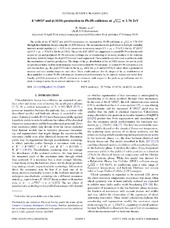K*(892)\(^0\) and \(\Phi\)(1020) production in Pb-Pb collisions at \(\sqrt{s_{NN}}\) = 2.76 TeV
Abelev, Betty; Adam, Jaroslav; Adamová, Dagmar; Aggarwal, Madan M.; Agnello, Michelangelo; Agostinelli, Andrea; Agrawal, Nikita; Ahammed, Zubayer; Ahmad, Nazeer; Ahmad Masoodi, Arshar; Alme, Johan; Erdal, Hege Austrheim; Helstrup, Håvard; Hetland, Kristin Fanebust; Kileng, Bjarte; Altinpinar, Sedat; Djuvsland, Øystein; Fehlker, Dominik; Haaland, Øystein Senneset; Huang, Meidana; Lønne, Per-Ivar; Nystrand, Joakim; Rehman, Attiq ur; Røhrich, Dieter; Skjerdal, Kyrre; Ullaland, Kjetil; Velure, Arild; Wagner, Boris; Yang, Shiming; Arsene, Ionut Christian; Bätzing, Paul Christoph; Dordic, Olja; Lindal, Svein; Milosevic, Jovan; Qvigstad, Henrik; Richter, Matthias Rudolph; Røed, Ketil; Skaali, Toralf Bernhard; Tveter, Trine Spedstad; Wikne, Jon Christopher; Zhao, Chengxin; Langøy, Rune; Lien, Jørgen André; Ahmed, Ijaz; Ahn, Sang Un; Ahn, Sul-Ah; Aimo, Ilaria; Aiola, Salvatore; Ajaz, Muhammad; Akindinov, Alexander; ALICE, Collaboration
Peer reviewed, Journal article
Published version

Åpne
Permanent lenke
https://hdl.handle.net/1956/16825Utgivelsesdato
2015-02Metadata
Vis full innførselSamlinger
Originalversjon
https://doi.org/10.1103/physrevc.91.024609Sammendrag
The yields of the K*(892)\)^0\) and \(\Phi\)(1020) resonances are measured in Pb-Pb collisions at \(\sqrt{s_{NN}}\) = 2.76 TeV through their hadronic decays using the ALICE detector. The measurements are performed in multiple centrality intervals at mid-rapidity (|y|<0.5) in the transverse-momentum ranges 0.3 < \(p_T\) < 5 GeV/c for the K*(892)\(^0\) and 0.5 < \(p_T\) < 5 GeV/c for the \(\Phi\)(1020). The yields of K*(892)\(^0\) are suppressed in central Pb-Pb collisions with respect to pp and peripheral Pb-Pb collisions. This suppression is discussed in a scenario in which the K*(892)\(^0\) decays during the evolution of the fireball and the decay products scatter, thus escaping detection through invariant-mass reconstruction. In contrast, the \(\Phi\)(1020) meson, due to its long lifetime, decays outside the fireball. These particles are also used as probes to study the mechanisms of particle production. The shape of the pt distribution of the \(\Phi\)(1020) meson, but not its yield, is reproduced fairly well by hydrodynamical models for central Pb-Pb collisions. In central Pb-Pb collisions at low and intermediate \(p_T\), the p/\(Phi\)(1020) ratio is flat in \(p_T\), while the p/\(pi)\) and \(\Phi\)(1020)/\)\pi\) ratios show a pronounced increase and have similar shapes to each other. These results indicate that the shapes of the \(p_T\) distributions of these particles in central Pb-Pb collisions are determined predominantly by the particle masses and radial flow. Finally, \(\Phi\)(1020) production in Pb-Pb collisions is enhanced, with respect to the yield in pp collisions and the yield of charged pions, by an amount similar to the \(\Lambda\) and \(\Xi\),
